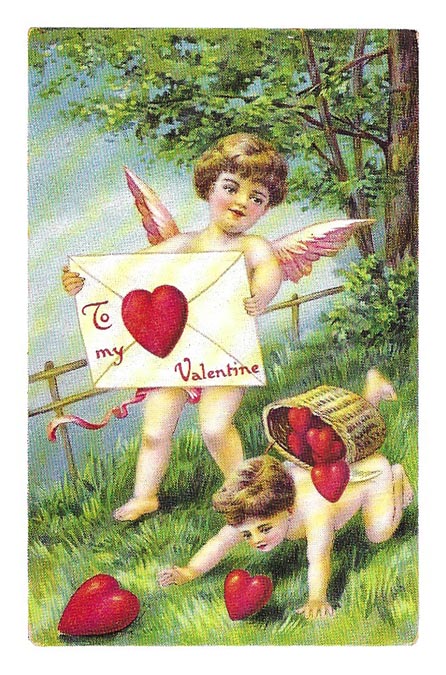
“Haste and bow at Cupid’s shrine and welcome in St. Valentine.
“All be merry, frank and free and form the Lover’s Jubilee.” —From a Valentine writer, 19th Century

British printers produced the first ready-made valentine cards in 1797. Images of popular love tokens were combined with inscribed verses. Fancy papers gave an air of luxury. Embossed sheets with rich relief designs and paper laces were used for handwritten and personalized valentine letters. Postage was so costly so to avoid excessive charges, most valentines had one sheet of paper, folded in thirds for privacy.
In the early 1800s a ready-made valentine had narrative scenes and hand-colored details, portraying happy couples strolling in blooming bowers, listening to love birds, and exchanging valentines. In her book “Love’s Messenger” by Debra N. Mancoff, the author writes of the history of Valentine’s Day. She elaborates on the tokens of affection in the Victorian Age.
Queen Victoria and Prince Albert set the model for Victorian courtship and marriage. Shortly after her accession in 1837, Victoria became engaged to the handsome German prince. Their wedding February 10, 1840, delighted all of England. Illustrated valentines portrayed them as ideal sweethearts. The image of the Queen’s portrait was embossed on valentine cards.
Ready-made valentines were popular in Victorian England. The first London stationery shops, including Dobbs and Company, produced their own specialized lines, using paper lace, ribbon, silk and cut-paper flowers and leaves. The penny post arrived in 1840 and contributed to the design of elaborate envelopes. In 1841 more than 400,000 valentines were delivered throughout England. By 1871 three times that many were sent in London.
The vogue for valentines soon came to the United States. The poet, Emily Dickinson, wrote to her brother of a delightful holiday in 1848: “I am sure I shall not very soon forget last Valentine week nor any the sooner, the fun I had at that time.” In New York, 30,000 valentines were mailed in 1847. A reporter for the Philadelphia Public Ledger claimed some postmen needed wheelbarrows to deliver their Valentine’s Day messages of “dainty epistles.”
Esther Howland was graduated from Mount Holyoke College and began working in her father’s stationery shop. She began making her own valentines. In 1849 she set up a factory and employed five women. Her “Maybasket” design used an extravagant combination of raised paper, artificial flowers, and leaves.
Every image on a valentine conveyed a message of love. Anchors and oak leavers proclaimed a sender’s fidelity and love birds and wedding rings illustrated honorable intentions. Flowers, of course, were a favorite symbol. Bouquet of blossoms had elaborate messages. A pansy with the message of “You capture my thoughts,” was an enduring favorite because it conveyed interest. Blue forget-me-nots told of a delicate and loving nature. Pink roses expressed the wish for romance. Little bluebells were for a lover’s constancy. Saint Valentine’s emblem was the crocus and this early Spring bloom indicated resolve.
In that Victorian time of gracious manners and quiet attentions, any thoughtless act such as an ungloved hand on a lady’s shoulder or a gentle finger brushing a stray curl could ruin a woman’s reputation. Victorian etiquette manuals warned against public displays of affection. In the book, Good Morals and Good Manners (1873), it was stated that “No gentleman will attempt, and no lady will permit” such indecorous acts.
This Valentine’s Day embroiders the daylight hours with thoughtfulness and love. Plan the evening hours with candlelight and roses. A hand-made Valentine will bring true affection to your gifts. Women appreciate the little gestures that show your love, especially hand-written sentiments in letters and cards. Enjoy a most Happy St. Valentine’s Day and weekend.

